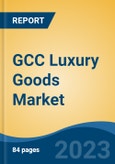Speak directly to the analyst to clarify any post sales queries you may have.
10% Free customizationThis report comes with 10% free customization, enabling you to add data that meets your specific business needs.
Luxury goods, often associated with wealth and exclusivity, differentiate themselves from basic necessities based on attributes such as rarity, symbolism, and quality. The GCC region is currently home to numerous luxury goods providers catering to affluent and discerning customers. The market offers a wide range of luxury items, including watches, luggage, apparel, jewelry, fragrances, and more.
The demand for luxury items in the region is also driven by celebrity endorsements and the widespread use of social media marketing. Additionally, the appeal of limited capsule collections and fashion drops has stimulated the demand for used luxury products. To ensure a secure and reliable environment for clients, many personal luxury platforms are investing in authentication procedures and quality inspections.
Recent technological advancements have brought significant changes to the consumer landscape. With the internet and mobile internet, consumers now have more flexibility to access information anytime and anywhere. The consumer journey has become more complex with the availability of various touchpoints across the sales funnel.
The emergence of online sales channels is expected to drive market growth. As e-retail continues to expand in the region, companies need to go beyond simple online selling. Influencer marketing, social media, and digital marketing play a crucial role in the digitization of luxury goods. In the projected period, online interactions will influence almost every luxury purchase, even those made in traditional retail settings. This emphasizes the sense of individuality associated with these brands. The COVID-19 pandemic has also highlighted the importance of diversifying customer reach beyond foot traffic and establishing enduring partnerships. Moreover, the connectivity of Middle Eastern customers is growing, with high internet penetration rates in Saudi Arabia and the United Arab Emirates, where online content greatly impacts purchase decisions.
In conclusion, with the increasing number of online sales channels, the GCC luxury goods market is poised to experience accelerated growth.
Growing Young Population Will Boost the Market Growth
The luxury brands in the region find themselves in a compelling position due to economic development, investment, and a growing population of affluent and youthful consumers. However, it is vital for luxury businesses to understand the goals and cultural expectations of the region's young population before embarking on innovative endeavors and aligning with their budgets. By seamlessly integrating the physical and digital realms, there exists a unique opportunity to redefine the luxury shopping experience for this forward-thinking generation. Furthermore, this presents a chance to foster growth, especially considering that the Gulf region has one of the world's fastest-growing populations, predominantly composed of individuals under the age of 25. Additionally, women are increasingly playing a significant role in the Gulf economy, accounting for 33% of the consumer base for luxury goods. With nearly 90% of the population residing in metropolitan areas and higher per capita income, the United Arab Emirates stands as the focal point of the luxury market in the Middle East. Therefore, the burgeoning young population will be the driving force behind the growth of the luxury goods market.The Market Growth Fueled by High Spending Power
A notable factor contributing to retail growth in the region is the distinctive combination of substantial government spending and significantly low taxes, made possible by the substantial profits of state-run oil companies. This combination results in a higher proportion of personal income available for expenditure on consumer luxury goods, consequently bolstering the potential for retail growth. International luxury brands are highly sought-after in the Gulf, driven by the preference of the region's Western corporate sector and a steady influx of tourists that supports the international retail market. For instance, Dubai Mall, currently the world's largest shopping mall, attracts 65 million visitors annually. During Ramadan and seasonal sales, fashion, accessories, watches, and jewelry witnessed a 20% increase in spending during the second quarter of 2022 compared to the preceding three months. As purchasing power continues to rise, the demand for luxury goods is poised to grow at an accelerated pace.Market Segmentation
The GCC luxury goods market is segmented based on product type, end user, distribution channel, country, and competitional landscape. Based on product type, the market is further fragmented into apparel, footwear, accessories, and others like cosmetics, etc. Based on end user the market is segmented into women and men. Based on distribution channel, the market is segmented into supermarkets/hypermarkets, exclusive stores, online, and others like multi-branded Stores, etc. Based on country, the market is divided into Saudi Arabia, UAE, Qatar, Oman, Bahrain, and Kuwait.Company Profiles
Al Tayer Group LLC, Etoile Company, AWR Group LLC, M. H. Alshaya Co. WLL, Cartier SA, Radwa Trading Company LLC (Chanel), Guccio Gucci S.p.A, Hermes International, FENDI S.r.l. and Louis Vuitton Malletier SAS have actively entered the market in recent years and further strengthen the market growth.Report Scope
In this report, GCC luxury goods market has been segmented into following categories, in addition to the industry trends which have also been detailed below:GCC Luxury Goods Market, by Product Type:
- Apparel
- Footwear
- Accessories
- Others
GCC Luxury Goods Market, by End User:
- Women
- Men
GCC Luxury Goods Market, by Distribution Channel:
- Supermarkets/Hypermarkets
- Exclusive Stores
- Online
- Others
GCC Luxury Goods Market, by Country:
- Saudi Arabia
- UAE
- Qatar
- Oman
- Bahrain
- Kuwait
Competitive Landscape
Company Profiles: Detailed analysis of the major companies present in GCC luxury goods market.Available Customizations
The following customization options are available for the report:- Detailed analysis and profiling of additional market players (up to five).
This product will be delivered within 1-3 business days.
Table of Contents
Companies Mentioned
- Al Tayer Group LLC
- Etoile Company
- AWR Group LLC
- M. H. Alshaya Co. WLL
- Cartier SA
- Radwa Trading Company LLC (Chanel)
- Guccio Gucci S.p.A
- Hermes International
- FENDI S.r.l.
- Louis Vuitton Malletier SAS








